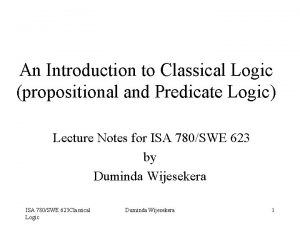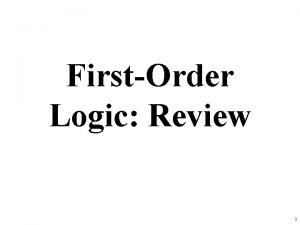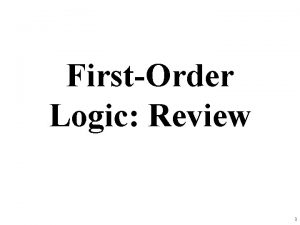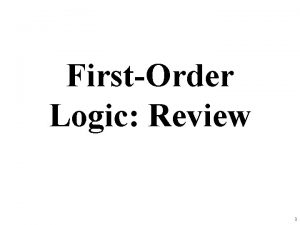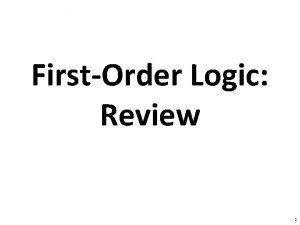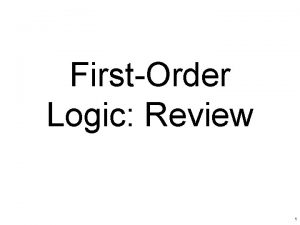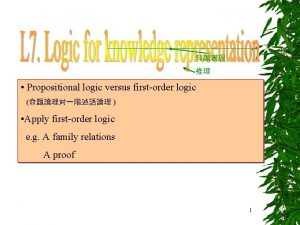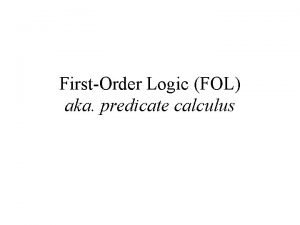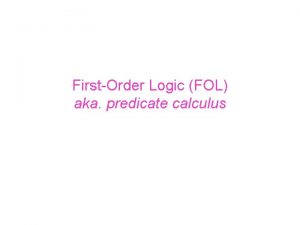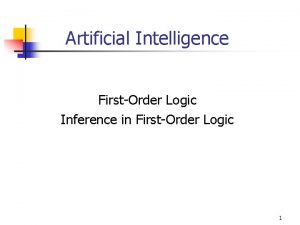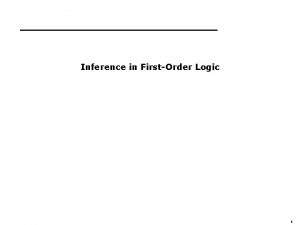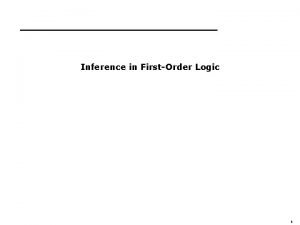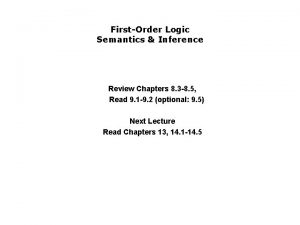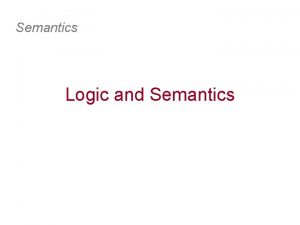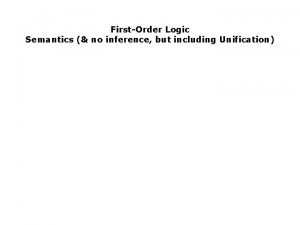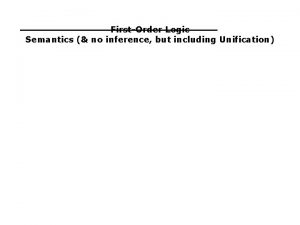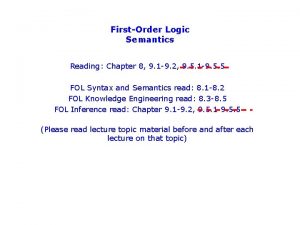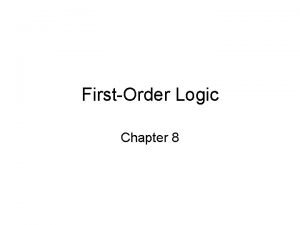FirstOrder Logic Review 1 RDFSOWL Semantics The semantics



























- Slides: 27

First-Order Logic: Review 1

RDFS/OWL Semantics • The semantics of RDFS and OWL are based on First Order Logic • Advantages: – Familiar, well defined, well understood, expressive, powerful – Good procedures/tools for inference • Disadvantages – No agreement on how to extend for probabilities, fuzzy representations, higher order logics, etc. 2

First-order logic • First-order logic (FOL) models the world in terms of – Objects, which are things with individual identities – Properties of objects that distinguish them from others – Relations that hold among sets of objects – Functions, which are a subset of relations where there is only one “value” for any given “input” • Examples: – Objects: Students, lectures, companies, cars. . . – Relations: Brother-of, bigger-than, outside, part-of, hascolor, occurs-after, owns, visits, precedes, . . . – Properties: blue, oval, even, large, . . . – Functions: father-of, best-friend, second-half, morethan. . .

User provides • Constant symbols representing individuals in the world – Mary, 3, green • Function symbols, map individuals to individuals – father_of(Mary) = John – color_of(Sky) = Blue • Predicate symbols, map individuals to truth values – greater(5, 3) – green(Grass) – color(Grass, Green)

FOL Provides • Truth values – True, False • Variable symbols – E. g. , x, y, foo • Connectives – Same as in propositional logic: not ( ), and ( ), or ( ), implies ( ), iff ( ) • Quantifiers – Universal x or (Ax) – Existential x or (Ex)

Sentences: built from terms and atoms • A term (denoting a real-world individual) is a constant symbol, variable symbol, or n-place function of n terms, e. g. : –Constants: john, umbc –Variables: x, y, z –Functions: mother_of(john), phone(mother(x)) • Ground terms have no variables in them –Ground: john, father_of(john)) –Not Ground: father_of(X)

Sentences: built from terms and atoms • An atomic sentence (which has value true or false) is an n-place predicate of n terms, e. g. : –green(Kermit)) –between(Philadelphia, Baltimore, DC) –loves(X, mother(X)) • A complex sentence is formed from atomic sentences connected by logical connectives: P, P Q, P Q

Sentences: built from terms and atoms • quantified sentences adds quantifiers and – x loves(x, mother(x)) – x number(x) greater(x, 100) prime(x) • A well-formed formula (wff) is a sentence containing no “free” variables, i. e. , all variables are “bound” by either a universal or existential quantifiers ( x)P(x, y) has x bound as a universally

Quantifiers • Universal quantification –( x)P(x) means P holds for all values of x in domain associated with variable –E. g. , ( x) dolphin(x) mammal(x) • Existential quantification –( x)P(x) means P holds for some value of x in domain associated with variable –E. g. , ( x) mammal(x) lays_eggs(x) –This lets us make a statement about some object without naming it

Quantifiers (1) • Universal quantifiers often used with implies to form rules: ( x) student(x) smart(x) means “All students are smart” • Universal quantification rarely used to make blanket statements about every individual in the world: ( x) student(x) smart(x) means “Everyone in the world is a student and is smart”

Quantifiers (2) • Existential quantifiers usually used with “and” to specify a list of properties about an individual: ( x) student(x) smart(x) means “There is a student who is smart” • Common mistake: represent this in FOL as: ( x) student(x) smart(x) • What does this sentence mean? – ? ?

Quantifier Scope • FOL sentences have structure, like programs • In particular, the variables in a sentence have a scope • For example, suppose we want to say – “everyone who is alive loves someone” – ( x) alive(x) ( y) loves(x, y) • Here’s how we scope the variables ( x) alive(x) ( y) loves(x, y) Scope of x Scope of y

Quantifier Scope • Switching order of universal quantifiers does not change the meaning – ( x)( y)P(x, y) ↔ ( y)( x) P(x, y) – “Dogs hate cats” (i. e. , “all dogs hate all cats”) • You can switch order of existential quantifiers – ( x)( y)P(x, y) ↔ ( y)( x) P(x, y) – “A cat killed a dog” • Switching order of universal and existential quantifiers does change meaning: – Everyone likes someone: ( x)( y) likes(x, y) – Someone is liked by everyone: ( y)( x) likes(x, y)

Procedural example 1 def verify 1(): # Everyone likes someone: ( x)( y) likes(x, y) for x in people(): found = False for y in people(): if likes(x, y): Every person has at least one individual that found = True they like. break if not Found: return False return True

Procedural example 2 def verify 2(): # Someone is liked by everyone: ( y)( x) likes(x, y) for y in people(): found = True for x in people(): There is a person who is if not likes(x, y): liked by every person in the universe. found = False break if found return True return False

Connections between and • We can relate sentences involving and using extensions to De Morgan’s laws: 1. ( x) P(x) ↔ ( x) P(x) 2. ( x) P(x) ↔ ( x) P(x) 3. ( x) P(x) ↔ ( x) P(x) 4. ( x) P(x) ↔ ( x) P(x) • Examples 1. All dogs don’t like cats ↔ No dogs like cats 2. Not all dogs dance ↔ There is a dog that doesn’t dance 3. All dogs sleep ↔ There is no dog that doesn’t sleep

Simple genealogy KB in FOL Design a knowledge base using FOL that – Has facts of immediate family relations, e. g. , spouses, parents, etc. – Defines of more complex relations (ancestors, relatives) – Detect conflicts, e. g. , you are your own parent – Infers relations, e. g. , grandparernt from parent – Answers queries about relationships between people

How do we approach this? • Design an initial ontology of types, e. g. – e. g. , person, man, woman, gender • Add general individuals to ontology, e. g. – gender(male), gender(female) • Extend ontology be defining relations, e. g. – spouse, has_child, has_parent • Add general constraints to relations, e. g. – spouse(X, Y) => ~ X = Y – spouse(X, Y) => person(X), person(Y) • Add FOL sentences for inference, e. g. – spouse(X, Y) spouse(Y, X) – man(X) person(X) ∧has_gender(X, male)

Simple genealogy KB in FOL • Has facts of immediate family relations, e. g. , spouses, parents, etc. • Has definitions of more complex relations (ancestors, relatives) • Can detect conflicts, e. g. , you are your own parent • Can infer relations, e. g. , grandparernt from parent • Can answer queries about relationships between people

Example: A simple genealogy KB by FOL • Predicates: – parent(x, y), child(x, y), father(x, y), daughter(x, y), etc. – spouse(x, y), husband(x, y), wife(x, y) – ancestor(x, y), descendant(x, y) – male(x), female(y) – relative(x, y) • Facts: – husband(Joe, Mary), son(Fred, Joe) – spouse(John, Nancy), male(John), son(Mark, Nancy) – father(Jack, Nancy), daughter(Linda, Jack) – daughter(Liz, Linda) – etc.

Example Axioms ( x, y) has_parent(x, y) ↔ has_child (y, x) ( x, y) father(x, y) ↔ parent(x, y) male(x) ; similar for mother(x, y) ( x, y) daughter(x, y) ↔ child(x, y) female(x) ; similar for son(x, y) ( x, y) husband(x, y) ↔ spouse(x, y) male(x) ; similar for wife(x, y) ( x, y) spouse(x, y) ↔ spouse(y, x) ; spouse relation is symmetric ( x, y) parent(x, y) ancestor(x, y) ( x, y)( z) parent(x, z) ancestor(z, y) ancestor(x, y) ( x, y) descendant(x, y) ↔ ancestor(y, x) ( x, y)( z) ancestor(z, x) ancestor(z, y) relative(x, y) ( x, y) spouse(x, y) relative(x, y) ; related by marriage

• Rules for genealogical relations ( x, y) parent(x, y) ↔ child (y, x) ( x, y) father(x, y) ↔ parent(x, y) male(x) ; similarly for mother(x, y) ( x, y) daughter(x, y) ↔ child(x, y) female(x) ; similarly for son(x, y) ( x, y) husband(x, y) ↔ spouse(x, y) male(x) ; similarly for wife(x, y) ( x, y) spouse(x, y) ↔ spouse(y, x) ; spouse relation is symmetric ( x, y) parent(x, y) ancestor(x, y) ( x, y)( z) parent(x, z) ancestor(z, y) ancestor(x, y) ( x, y) descendant(x, y) ↔ ancestor(y, x) ( x, y)( z) ancestor(z, x) ancestor(z, y) relative(x, y) ; related by common ancestry ( x, y) spouse(x, y) relative(x, y) ; related by marriage ( x, y)( z) relative(z, x) relative(z, y) relative(x, y) ; transitive ( x, y) relative(x, y) ↔ relative(y, x) ; symmetric • Queries – ancestor(Jack, Fred) ; the answer is yes – relative(Liz, Joe) ; the answer is yes – relative(Nancy, Matthew) ; no answer, no under closed world assumption – ( z) ancestor(z, Fred) ancestor(z, Liz)

Axioms, definitions and theorems • Axioms: facts and rules that capture the (important) facts and concepts about a domain; axioms can be used to prove theorems – Mathematicians dislike unnecessary (dependent) axioms, i. e. ones that can be derived from others – Dependent axioms can make reasoning faster, however – Choosing a good set of axioms is a design problem • A definition of a predicate is of the form “p(X) ↔ …” and can be decomposed into two parts – Necessary description: “p(x) …” – Sufficient description “p(x) …” – Some concepts have definitions (triangle) and some do not (person)

More on definitions Example: define father(x, y) by parent(x, y) and male(x) • parent(x, y) is a necessary (but not sufficient) description of father(x, y) parent(x, y) • parent(x, y) ^ male(x) ^ age(x, 35) is a sufficient (but not necessary) description of father(x, y): father(x, y) parent(x, y) ^ male(x) ^ age(x, 35) • parent(x, y) ^ male(x) is a necessary and sufficient description of father(x, y) parent(x, y) ^ male(x) ↔ father(x, y)

Notational differences • Different symbols for and, or, not, implies, . . . – – p v (q ^ r) – p + (q * r) • Prolog cat(X) : - furry(X), meows (X), has(X, claws) • Lispy notations (forall ? x (implies (and (furry ? x) (meows ? x) (has ? x claws))

A example of FOL in use • Semantics of W 3 C’s semantic web stack (RDF, RDFS, OWL) is defined in FOL • OWL Full is equivalent to FOL • Other OWL profiles support a subset of FOL and are more efficient • However, the semantics of schema. org is only defined in natural language text • …and Google’s knowledge Graph probably (!) uses probabilities 27

FOL Summary • First order logic (FOL) introduces predicates, functions and quantifiers • More expressive, but reasoning more complex – Reasoning in propositional logic is NP hard, FOL is semi-decidable • Common AI knowledge representation language – Other KR languages (e. g. , OWL) are often defined by mapping them to FOL • FOL variables range over objects
 Compare procedural semantics and declarative semantics.
Compare procedural semantics and declarative semantics. Predicate logic example
Predicate logic example First order logic vs propositional logic
First order logic vs propositional logic First order logic vs propositional logic
First order logic vs propositional logic Third order logic
Third order logic Combinational logic circuit vs sequential
Combinational logic circuit vs sequential Cryptarithmetic problem logic+logic=prolog
Cryptarithmetic problem logic+logic=prolog 캠블리 단점
캠블리 단점 Is it x y or y x
Is it x y or y x Combinational logic sequential logic 차이
Combinational logic sequential logic 차이 Combinational logic sequential logic
Combinational logic sequential logic Hát kết hợp bộ gõ cơ thể
Hát kết hợp bộ gõ cơ thể Slidetodoc
Slidetodoc Bổ thể
Bổ thể Tỉ lệ cơ thể trẻ em
Tỉ lệ cơ thể trẻ em Voi kéo gỗ như thế nào
Voi kéo gỗ như thế nào Tư thế worm breton
Tư thế worm breton Hát lên người ơi
Hát lên người ơi Các môn thể thao bắt đầu bằng tiếng nhảy
Các môn thể thao bắt đầu bằng tiếng nhảy Thế nào là hệ số cao nhất
Thế nào là hệ số cao nhất Các châu lục và đại dương trên thế giới
Các châu lục và đại dương trên thế giới Công thức tính độ biến thiên đông lượng
Công thức tính độ biến thiên đông lượng Trời xanh đây là của chúng ta thể thơ
Trời xanh đây là của chúng ta thể thơ Cách giải mật thư tọa độ
Cách giải mật thư tọa độ Làm thế nào để 102-1=99
Làm thế nào để 102-1=99 Phản ứng thế ankan
Phản ứng thế ankan Các châu lục và đại dương trên thế giới
Các châu lục và đại dương trên thế giới Thể thơ truyền thống
Thể thơ truyền thống

